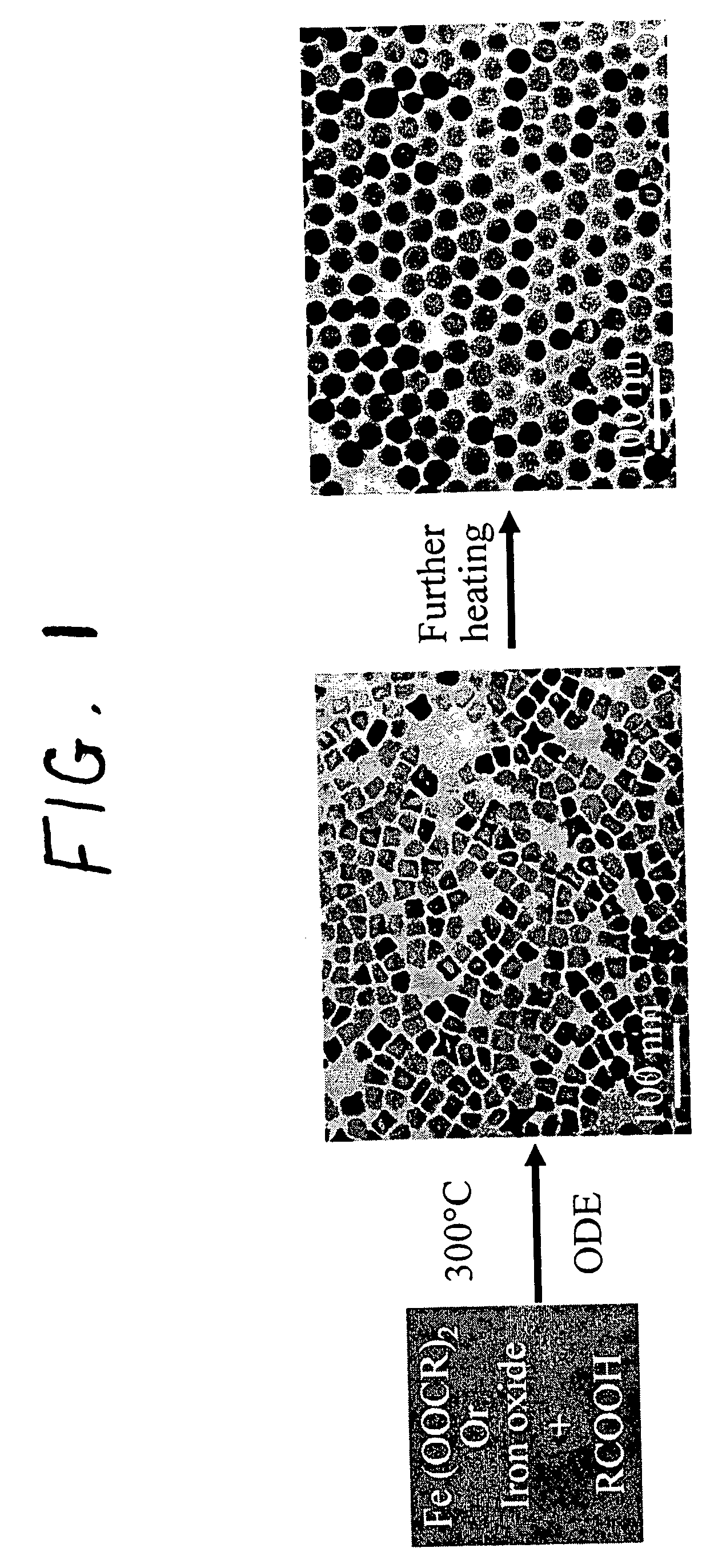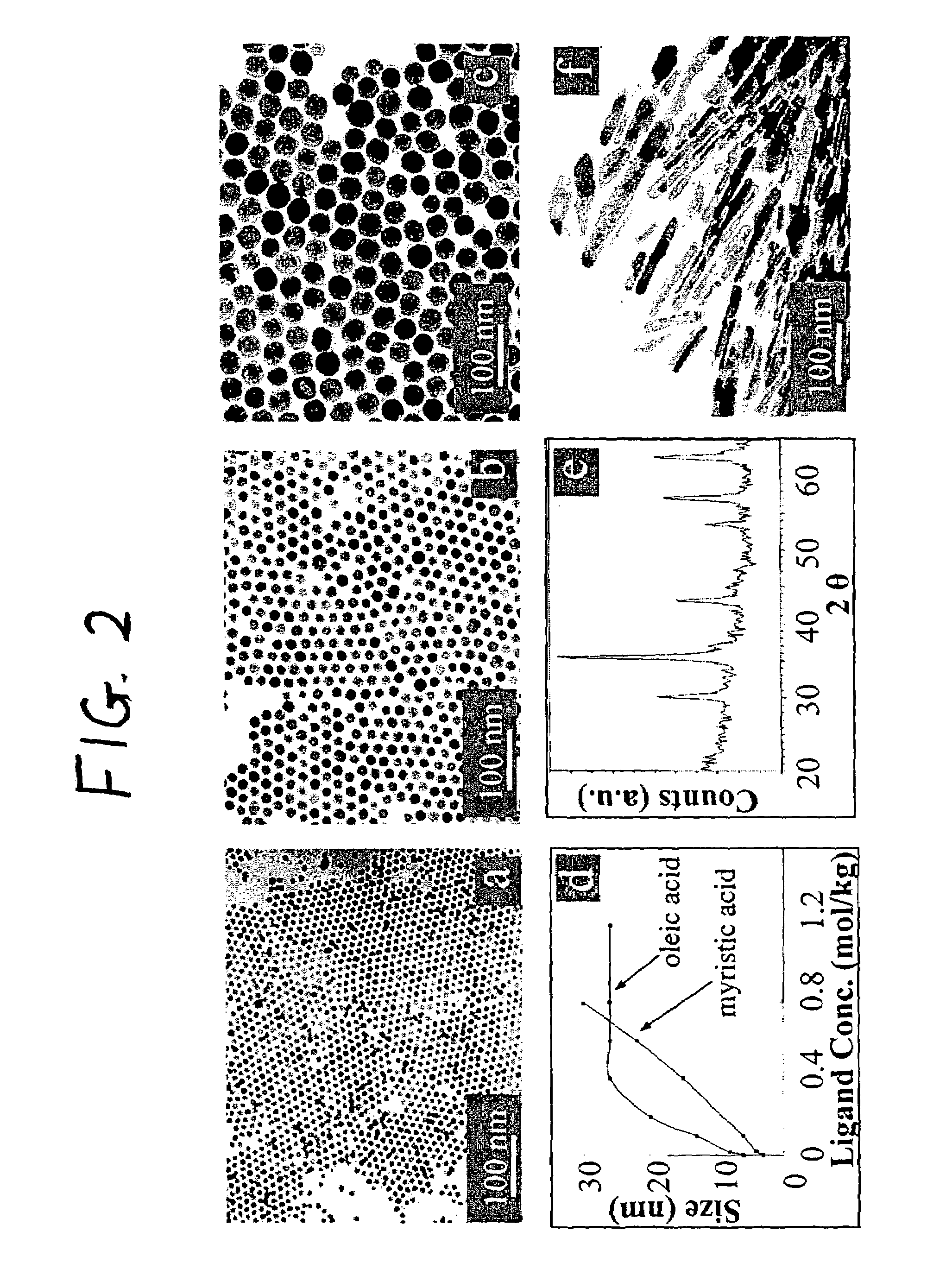Synthetic control of metal oxide nanocrystal sizes and shapes
a technology of metal oxide nanocrystals and nanoparticles, which is applied in the direction of chromium oxide/hydrates, magnetic materials, turning machines, etc., can solve the problems of difficult to develop a general synthesizing strategy for monodisperse magnetic oxide nanocrystals with size and shape control, and inability to generalize the synthesis method of monodisperse high-quality nanocrystals
- Summary
- Abstract
- Description
- Claims
- Application Information
AI Technical Summary
Benefits of technology
Problems solved by technology
Method used
Image
Examples
example 1
Preparation of Fe(II) / Fe(III) Oleate
[0074]5.4 g of FeCl3.6H2O or 4 g FeCl2.4H2O was dissolved in 100 mL of methanol and then oleic acid was added in three equivalents (17 mL, technical grade, 90%) for ferric salt and two equivalents (11 mL, technical grade, 90%) for ferrous salt. Next, 2.4 g (for ferric) or 1.6 g (for ferrous) of NaOH was dissolved in 200 mL of methanol and mixed drop-wise under the magnetically stirring condition. The observed brown precipitate was washed with methanol by 4-5 times and dried under vacuum for overnight to remove all solvents. The brown colored solid mass was dissolved in 20 mL of 1-octadecene (technical grade, 90%) at 60-70° C. and preserved (without precipitate) in room temperature for stock solution.
example 2
Preparation of Iron Oxide Nanocrystals
[0075]The iron oxide nanoparticles were prepared by the decomposition of iron-oleate complexes at 300° C. using octadecene as the solvent. The particle sizes can be controlled between about 8 and about 50 nm, by varying the amount of excess oleic acid, or by changing the concentration of precursor salt during the reaction. Other non-spherical shapes such as cubes or spheroids were also obtained by freezing the reaction at early stages. In a typical synthesis, 1 mL of stock solution is mixed with 4 mL of octadecene and appropriate amount of oleic acid (from 0.1 equivalent to 10 equivalent) and the mixture was heated to 300° C. under an argon atmosphere. The reaction progress is monitored, taking a small portion of the sample in toluene in room temperature (and thus freezing the reaction) in different time interval and investigated this sample under TEM.
[0076]The final size and size distribution strongly depended on the starting reaction condition...
example 3
Iron Oxide Nanoparticle Using Fe(II)-stearate as Precursor
[0082]Using Fe(II)-stearate as precursor, iron oxide nanoparticles of 3 nm can be prepared. In a typical synthesis, 0.622 g iron stearate and 0.269 g octadecylamine was mixed with 5 mL of octadecene and heated to 300° C. under argon atmosphere. The reaction was stopped after 15 minutes of heating.
PUM
| Property | Measurement | Unit |
|---|---|---|
| temperature | aaaaa | aaaaa |
| particle size | aaaaa | aaaaa |
| molar ratio | aaaaa | aaaaa |
Abstract
Description
Claims
Application Information
 Login to View More
Login to View More - R&D
- Intellectual Property
- Life Sciences
- Materials
- Tech Scout
- Unparalleled Data Quality
- Higher Quality Content
- 60% Fewer Hallucinations
Browse by: Latest US Patents, China's latest patents, Technical Efficacy Thesaurus, Application Domain, Technology Topic, Popular Technical Reports.
© 2025 PatSnap. All rights reserved.Legal|Privacy policy|Modern Slavery Act Transparency Statement|Sitemap|About US| Contact US: help@patsnap.com



